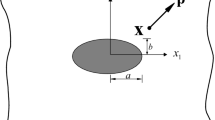Abstract
The Eshelby problem of an infinite homogeneous isotropic elastic material containing an inclusion is analytically solved using a simplified strain gradient elasticity theory that involves one material length scale parameter in addition to two classical elastic constants. The Green’s function in the simplified strain gradient elasticity theory is first obtained in terms of elementary functions by applying Fourier transforms, which reduce to the Green’s function in classical elasticity when the strain gradient effect is not considered. The Eshelby tensor is then derived in a general form for an inclusion of arbitrary shape, which consists of a classical part and a gradient part. The former contains Poisson’s ratio only, while the latter includes the length scale parameter additionally, thereby enabling the interpretation of the size effect. By applying the general form of the Eshelby tensor derived, the explicit expressions of the Eshelby tensor for the special case of a spherical inclusion are obtained. The numerical results quantitatively show that the components of the new Eshelby tensor for the spherical inclusion vary with both the position and the inclusion size, unlike their counterparts based on classical elasticity. It is found that when the inclusion radius is small, the contribution of the gradient part is significantly large and thus should not be ignored. For homogenization applications, the volume average of this newly obtained Eshelby tensor over the spherical inclusion is derived in a closed form. It is observed that the components of the averaged Eshelby tensor change with the inclusion size: the smaller the inclusion radius, the smaller the components. Also, these components are seen to approach from below the values of their counterparts based on classical elasticity when the inclusion size becomes sufficiently large.
Similar content being viewed by others
References
Eshelby J.D.: The determination of the elastic field of an ellipsoidal inclusion, and related problems. Proc. R. Soc. Lond. A 241, 376–396 (1957)
Eshelby J.D.: The elastic field outside an ellipsoidal inclusion. Proc. R. Soc. Lond. A 252, 561–569 (1959)
Mori T., Tanaka K.: Average stress in matrix and average elastic energy of materials with misfitting inclusions. Acta Metall. 21, 571–574 (1973)
Weng G.J.: Some elastic properties of reinforced solids, with special reference to isotropic ones containing spherical inclusions. Int. J. Eng. Sci. 22, 845–856 (1984)
Mura T.: Micromechanics of Defects in Solids, 2nd edn. Martinus Nijhoff, Dordrecht (1987)
Zhao Y.H., Tandon G.P., Weng G.J.: Elastic moduli for a class of porous materials. Acta Mech. 76, 105–130 (1989)
Nemat-Nasser S., Hori M.: Micromechanics: Overall Properties of Heterogeneous Materials, 2nd edn. Elsevier Science, Amsterdam, The Netherlands (1999)
Qu J., Cherkaoui M.: Fundamentals of Micromechanics of Solids. Wiley, Hoboken, NJ (2006)
Li S., Wang G.: Introduction to Micromechanics and Nanomechanics. World Scientific, Singapore (2008)
Lloyd D.J.: Particle reinforced aluminum and magnesium matrix composites. Int. Mater. Rev. 39, 1–23 (1994)
Kouzeli M., Mortensen A.: Size dependent strengthening in particle reinforced aluminum. Acta Mater. 50, 39–51 (2002)
Gao X.-L.: Analytical solution for the stress field around a hard spherical particle in a metal matrix composite incorporating size and finite volume effects. Math. Mech. Solids 13, 357–372 (2008)
Cheng Z.-Q., He L.-H.: Micropolar elastic fields due to a spherical inclusion. Int. J. Eng. Sci. 33, 389–397 (1995)
Cheng Z.-Q., He L.-H.: Micropolar elastic fields due to a circular cylindrical inclusion. Int. J. Eng. Sci. 35, 659–668 (1997)
Ma H.S., Hu G.K.: Eshelby tensors for an ellipsoidal inclusion in a micropolar material. Int. J. Eng. Sci. 44, 595–605 (2006)
Liu X.N., Hu G.K.: Inclusion problem of microstretch continuum. Int. J. Eng. Sci. 42, 849–860 (2004)
Kiris A., Inan E.: Eshelby tensors for a spherical inclusion in microstretch elastic fields. Int. J. Solids Struct. 43, 4720–4738 (2006)
Zheng Q.-S., Zhao Z.-H.: Green’s function and Eshelby’s fields in couple-stress elasticity. Int. J. Multiscale Comput. Eng. 2, 15–27 (2004)
Kiris A., Inan E.: Eshelby tensors for a spherical inclusion in microelongated elastic fields. Int. J. Eng. Sci. 43, 48–58 (2005)
Zhang X., Sharma P.: Inclusions and inhomogeneities in strain gradient elasticity with couple stresses and related problems. Int. J. Solids Struct. 42, 3833–3851 (2005)
Ma H.S., Hu G.K.: Eshelby tensors for an ellipsoidal inclusion in a microstretch material. Int. J. Solids Struct. 44, 3049–3061 (2007)
Lakes R.: Experimental methods for study of Cosserat elastic solids and other generalized elastic continua. In: Muhlhaus, H. (eds) Continuum Models for Materials with Micro-Structure., pp. 1–22. Wiley, New York (1995)
Lam D.C.C., Yang F., Chong A.C.M., Wang J., Tong P.: Experiments and theory in strain gradient elasticity. J. Mech. Phys. Solids 51, 1477–1508 (2003)
Maranganti R., Sharma P.: A novel atomistic approach to determine strain-gradient elasticity constants: Tabulation and comparison for various metals, semiconductors, silica, polymers and the (ir) relevance for nanotechnologies. J. Mech. Phys. Solids 55, 1823–1852 (2007)
Koiter W.T.: Couple-stresses in the theory of elasticity: I and II. Proc. K. Ned. Akad. Wet. B 67, 17–44 (1964)
Altan B.S., Aifantis E.C.: On some aspects in the special theory of gradient elasticity. J. Mech. Behav. Mater. 8, 231–282 (1997)
Gao X.-L., Park S.K.: Variational formulation of a simplified strain gradient elasticity theory and its application to a pressurized thick-walled cylinder problem. Int. J. Solids Struct. 44, 7486–7499 (2007)
Timoshenko S.P., Goodier J.N.: Theory of Elasticity, 3rd edn. McGraw-Hill, New York (1970)
Polyzos D., Tsepoura K.G., Tsinopoulos S.V., Beskos D.E.: A boundary element method for solving 2-D and 3-D static gradient elastic problems. Part I. Integral formulation. Comput. Methods Appl. Mech. Eng. 192, 2845–2873 (2003)
Li S., Sauer R.A., Wang G.: The Eshelby tensors in a finite spherical domain. Part I. Theoretical formulations. ASME J. Appl. Mech. 74, 770–783 (2007)
Author information
Authors and Affiliations
Corresponding author
Rights and permissions
About this article
Cite this article
Gao, XL., Ma, H.M. Green’s function and Eshelby’s tensor based on a simplified strain gradient elasticity theory. Acta Mech 207, 163–181 (2009). https://doi.org/10.1007/s00707-008-0109-4
Received:
Revised:
Published:
Issue Date:
DOI: https://doi.org/10.1007/s00707-008-0109-4




